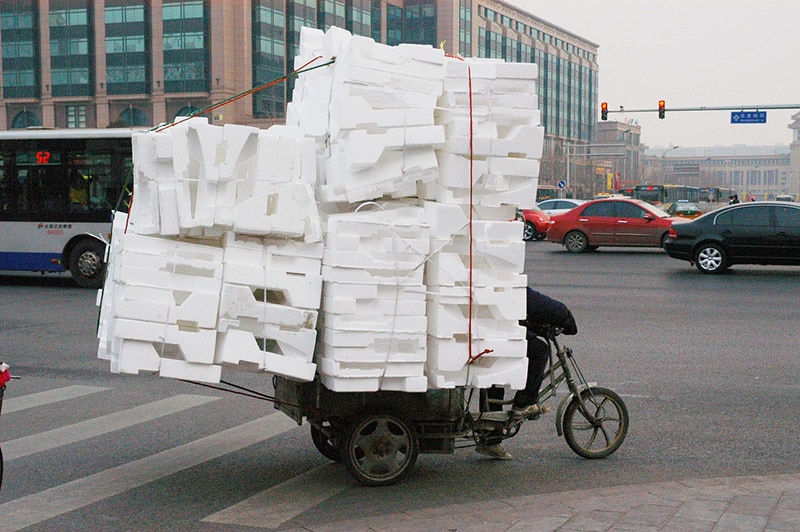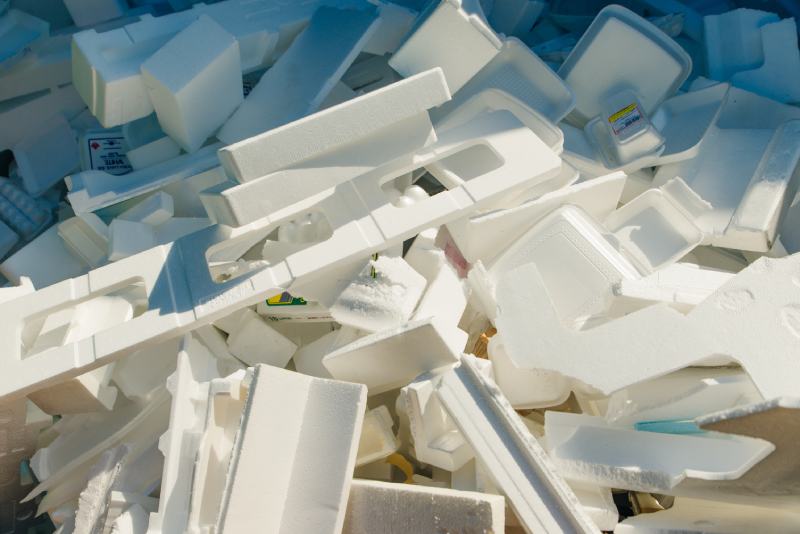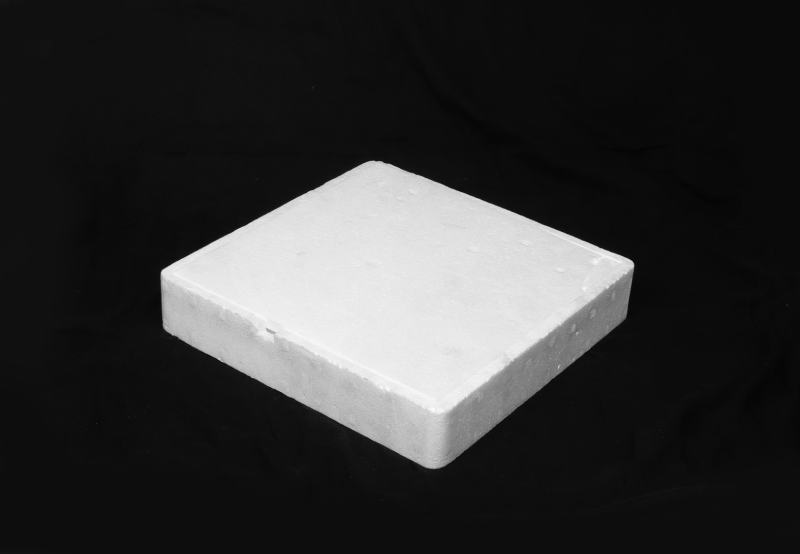Is Thermocol Recyclable? How Is It Properly Disposed Of?
-
Pete Ortiz
- Last updated:

Thermocol (also known as polystyrene)is a synthetic polymer that’s often used for insulation. Cheap, easy to manufacture, and long-lasting, it’s also a go-to material in commercial packaging. But can you recycle thermocol? Technically, yes, you can do that, but not in a regular bin. Just like any other type of plastic, polystyrene takes forever to decompose.
Instead, you should take your sheets to the closest recycling center that has the proper equipment for disposal. How do you find such a facility in your area, though? What are the alternatives to thermocol? These are just some of the questions that we’ll cover in this detailed guide. So, if you’re ready to recycle it without harming the planet, keep reading!
What Is Thermocol? Breaking It Down
This synthetic polymer doesn’t have a taste or odor. More importantly, it’s highly flexible and lasts for many decades. Resistance to abnormal humidity levels/moisture and photolysis is another big pro. Thermocol slabs are usually white but it won’t take much effort to paint them. With that said, you need to be careful not to cut or break thermocol because it can be fragile (although not as brittle as Styrofoam).
Most thermocol slates are 50×50, 50×100, and 100×100 and 0.6–1.0 inches in width. Now, thermocol is an EPS (short for expanded polystyrene). Its biggest advantage over similar materials is pliability. In the right hands, it can turn into all kinds of different objects. It’s made of petroleum, by the way, just like plastic. All these factors make it perfect for packaging.

Common Uses for Thermocol
Packaging and construction are the two areas where thermocol is commonly used. It’s lightweight and fungi-resistant, which makes it a perfect choice for packaging food and medical products. Thermocol is a great pick for furniture and electronics packaging as well. As for construction, thanks to polystyrene’s insulating properties, it does a great job of keeping hot air in.
If you live in a northern state with brutally cold winters, thermocol won’t let the precious warm air escape into the atmosphere. It won’t let the freezing air in, either. In contrast, during a hot summer, you’ll get to enjoy the lower temps set by the air conditioner while keeping the sizzling hot outside air at bay. As a bonus, you’ll lower the energy bill because the furnace or the conditioner won’t have to work very hard.
Here’s a quick look at what this material is used for:
- Protective packaging (CD and DVD cases, jewel cases for storage)
- Food packaging (oil-, grease-, and water-resistant containers)
- Single-use cups and take-out boxes from grocery stores/cafes
- Furniture packaging (for anti-impact protection during transit)
- Electronic packaging (TVs, computers, chips, other hardware)
- Medical packaging (storage kits and supply boxes)
Can Thermocol Be Recycled?
Let’s start by saying that the majority of plastics are recyclable. But, unfortunately, synthetic substances take a VERY long time to break down. That’s exactly why thermocol is not categorized as an environment-friendly product—it’s non-biodegradable. It won’t break down if you put it into a compost pile right next to waste from your kitchen and yard.
No matter how much water you add to it or how good you are at turning piles, this polystyrene won’t decompose. Air circulation and worms won’t be able to “jump-start” the process, either. This is important: most recycling facilities use a specific set of chemicals and lots of heat to get the job done. But thermocol is quick to melt. Furthermore, it releases harmful chemicals when burned.

Maybe You Should Burn It Instead?
No, burning thermocol is NOT recommended. The reason it’s extremely hazardous when burnt because of the toxins that are released into the atmosphere. We’re talking about styrene vapors, carbon monoxide, and carbon black, along with PAHs. These chemicals are highly dangerous when inhaled. For example, carbon monoxide CO doesn’t have an odor or color (you can’t see or smell it), yet it’s highly lethal.
So, while it might seem like a sound idea at first, burning polystyrene is equally dangerous for people (breathing in all those toxins can lead to dire consequences) and bad for the environment. Besides, you won’t be able to turn it into ashes quickly. This applies to most synthetic polymers, by the way. At the core, they are the same, despite the differences in chemical composition.
How Do You Dispose of Thermocol? A Quick Guide
We just learned that thermocol doesn’t degrade and can’t be properly processed at most recycling centers. That means it will end up in a landfill and stay there for eternity. Thus, putting it into a recycling bin won’t do any good for the environment. Instead, it will be extra work for the staff at the recycling plant. So, what’s the best way to dispose of it? Well, you can take it to a large recycling facility that has the necessary equipment.
Unfortunately, there aren’t nearly enough centers like that in the US. Still, do take a moment to find the closest one in the area and deliver the thermocol. Or, if you’re lucky, the government will arrive at your spot and pick it all up. Get in contact with local authorities to check whether there’s a curbside recycling program in your city or not. This won’t cost a single penny, of course.
Why Not Try and Reuse It?
If you live in a small town and have to drive for hours to the nearest facility that accepts thermocol, you might want to consider reusing it. This is especially true for people that run small businesses and constantly deliver packages with fragile items. And let’s not forget about polystyrene’s excellent insulation capabilities. If you have lots of thermocol lying around in the garage, use it to make the house warmer.
Lastly, thermocol serves as a perfect container for an outside garden. Make a couple of holes at the bottom for drainage, add some soil into the box, and now you have a pot! This material easily handles moisture and exposure to the sun, plus it lasts for decades. On top of that, it does a decent job of keeping the plants nice and warm during cold winter days. And if you’re a creative person, use it for craft projects.
Thermocol vs Styrofoam: What’s the Difference?
These terms are often used interchangeably, but we’re actually dealing with two different materials here. As mentioned, thermocol is an EPS, while Styrofoam is an XPS (stands for extruded polystyrene). So, what sets them apart, exactly? Thermocol is one of the most durable, lightweight, and easy-to-work-with “tools” in any construction worker’s arsenal.
It takes little effort to shape to your liking and boasts above-average resistance to humidity and shock absorption. As for Styrofoam, it’s harder, more rigid, and is naturally resistant to gamma radiation. It’s not very strong against UV rays or chemicals, though. Both materials are widely used in packaging (containers, disposable cups) and insulation for walls, floors, and ceilings.
What’s the Best Alternative to Thermocol?
If you’re not 100% happy with thermocol, you can always go with paper honeycomb. Common applications for it are identical to that of thermocol. The list includes packaging, boxes, pallets, and, of course, sealing/insulation. Honeycomb has extended burst strength, can take a “beating” and is even more lightweight compared to thermocol. So, why honeycomb? The structure is similar to beehives.
The big question is—which product will be the right pick for you? That depends on what you’re going for. The most significant advantage of honeycomb over polystyrene materials is its structure. This is a 100% eco-friendly and biodegradable option. However, it’s not as long-lasting and its load-bearing properties aren’t as impressive compared to plastic.
- Related Read: What Is Polystyrene? How Is It Made?
 Conclusion
Conclusion
If you’ve ever had the privilege of unpacking a TV, laptop, or some glass products, you’re no stranger to thermocol. It’s used to keep expensive stuff from harm’s way, especially when it’s transported by a truck or a plane. Thermocol is an excellent choice for thermal and sound insulation as well. So, it’s safe to assume that most of us have some lying around in the house.
Today, we learned how to dispose of it properly to protect the environment and help the economy. Polystyrene can’t be composted, degraded, or burned. And while there aren’t that many facilities in the States that can recycle it, you shouldn’t have a hard time finding one. All it will take is some patience and dedication!
Featured Image Credit: PublicDomainPictures, Pixabay
Contents


 Conclusion
Conclusion